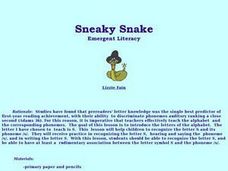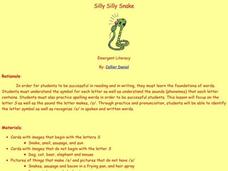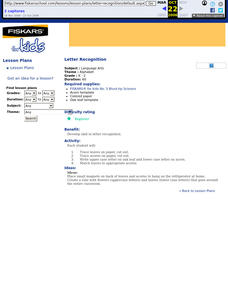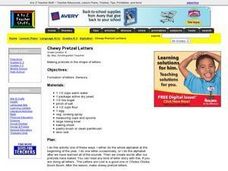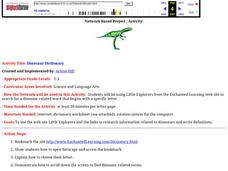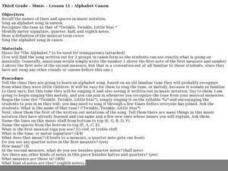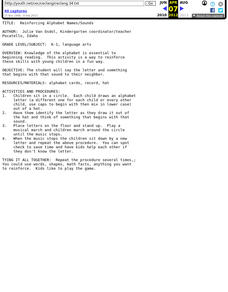Curated OER
Give Me A B
Students investigate the letter "b" and how it occurs in different words. They look at the beginning of words specifically to find the letter "b". Students use a worksheet during guided practice. The teacher reads various alphabet books...
Curated OER
Class Alphabet Book
Students are introduced to the Kid Pix software program and its templates. With a partner, they use the internet find a picture that starts with each letter of the alphabet. They practice saying and reading the words to their partner for...
Curated OER
ESOL Alphabet Recognition
Students recognize, state, read and write the alphabet (upper and lower cases) and numbers. They identify the letters, pronounce their name with the letters out of sequence and in sequence.
Curated OER
ADULT ESOL LESSON PLAN--Skills Necessary to Listen, Speak, Read and Write Effectively
Students, referring to the alphabet and numbers, practice stating, reading and writing letters and numbers. As they write each letter and number they say each one as well. They find examples of each one in a newspaper or magazine ad.
Curated OER
Sneaky Snake Emergent Literacy
Students are introduced to letters of the alphabet, specifically the letter S. Students recognize the letter S and its phoneme /s/ and receive practice in recognizing the letter S, hearing and saying the phoneme /s/, and in writing the...
Curated OER
The B Beat
Students recognize letter b in print and respective phoneme /b/ in spoken words, such as tongue twisters. Students then listen for phoneme in spoken words, and practice writing letter b.
Curated OER
Emergent Literacy
Students practice speaking and spelling words, and recognize and demonstrate understanding of sounds (phonemes) that each letter contains. Students focus specifically on letter S and its sound.
Curated OER
"Mmmm... Yummy to My Tummy!"
Students answer a series of question about different letter sounds. They verbally practice the sounds of each letter following set responses. They write the different letters and find words that start with that letter.
Curated OER
Letter Recognition
Learners develop skills in letter recognition. They trace leaves on paper cut outs. Students write upper case letters on oak leafs and lower case letters on acorns. They match leaves to appropriate acorns.
Curated OER
ABC It's Easy as 1..2..3..
Students listen to an alphabet book. They explore initial sounds throught the creation of a classroom ABC book. This lesson requires a program application, "Pixie."
Curated OER
The Alphabet Game
Pupils participate in a game in which they spell words. They work together to help each other with sounds and letters. The group with the most points wins the game.
Curated OER
Chewy Pretzel Letters
Students, with help of teacher, create pretzels shaped like letters. They then bake the pretzels and create words with the pretzel letters.
Curated OER
Scented Cool Whip Painting
Students practice their writing skills by "painting" pictures and writing letters in Cool Whip on paper.
Curated OER
Dinosaur Dictionary
Students utilize a web site to search for a dinosaur related word that begins with a specific letter. The words and their definitions are placed into a dictionary page which is then compiled into a class book.
Curated OER
Vocabulary Challenge
Students participate in a vocabulary challenge in which they are to name objects with the chosen letter.
Curated OER
Bonkers About Beads
Students explore written communication of different cultures, practice identifying letters of the alphabet, and recognize and create patterns with beaded letters.
Curated OER
Alphabetical Insects
Students research using the internet, the library, and other sources to create a list of insects beginning with each letter of the alphabet. They provide the common name, the resource where it was found, and a brief description of each...
Curated OER
A Statistical Study on the Letters of the Alphabet
Young scholars see that there are mathematical rules that can affect our use of the English language. Calculate the probability of picking any letter at random from a piece of English literature.
Curated OER
Alphabet Soup
Students play a game in which they use the letters of the alphabet and different motor skills for review.
Curated OER
Alphabet, Vegetable, and Chicken Noodle Parachute Soup
Students throw in their letter or vegetable when the said object or letter is said by the teacher. They also explore how to make a parachute ripple and make waves.
Curated OER
Alphabet Canon
Third graders recall the names of lines and spaces in music notation. They sing an alphabet song in unison and recognize the tune as that of Twinkle, Twinkle, Little Star. They identify meter signature, quarter, half, and eighth notes.
Curated OER
Alternative Alphabet
Students determine and compare hieroglyph content and frequency to sentences constructed in an alternative alphabet based on symbols that mimic sounds of the alphabet. They decide which images are hieroglyphs and which ones are not.
Curated OER
Reinforcing Alphabet Names/Sounds
Students reinforce knowledge of the alphabet essential to beginning reading by pulling random letters out of a hat and identifying the letter's sound.
Curated OER
Alternative Alphabet
Young scholars determine and compare hieroglyph content and frequency to an alternative alphabet based on symbols that mimic sounds of the alphabet.






